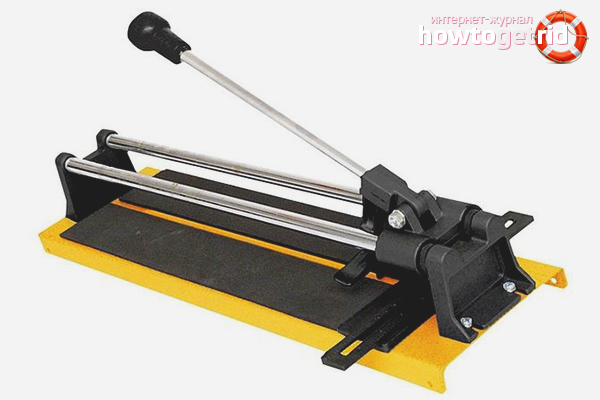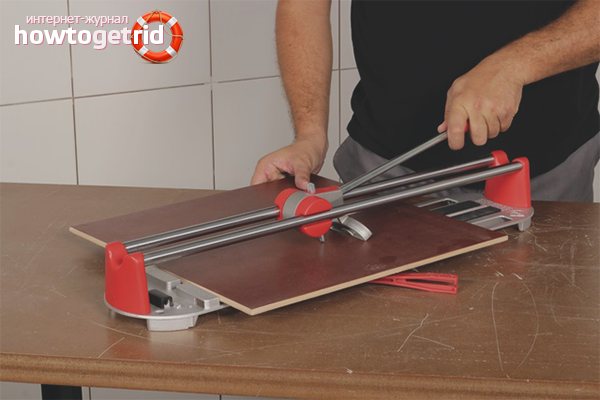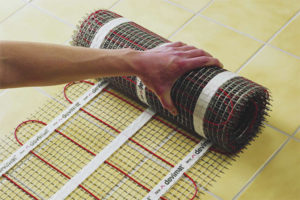The content of the article
Redecoration is often associated with laying ceramics. It is used for cladding walls and floors in the bathroom, kitchen or toilet. Laying tile, you need to use a special tool. Such a device is called a manual tile cutter - a simple and convenient device for processing ceramics.
To properly veneer the surface with tiles, you need to be able to use a manual tile cutter. During operation, it is always necessary to cut ceramics into fragments of a suitable size. This article will help you learn how to properly use the manual tile cutter.
What is a manual tile cutter: advantages and disadvantages
The principle of operation of this device resembles the work of a conventional glass cutter. Using a roller cutter, a shallow groove is made on the surface of the tile. And then press the foot, breaking the tile along the cut line.
Advantages of manual tile cutter:
- does not depend on electricity;
- cuts a tile up to 20 mm thick;
- does not require special storage conditions or special premises;
- applicable in all weather conditions when it is wet or dry, cold or hot;
- has a small size, allowing you to conveniently arrange it on a table or on the floor;
- It has a low weight due to which it is easy to carry it from one place to another.
Disadvantages of manual tile cutter:
- not suitable for the treatment of extremely durable types of tile;
- will not cope with the large volume of tiles;
- Do not cut strips of tiles of 5-10 mm.
How to choose a manual tile cutter
It is recommended to first buy a tile, and then tile cutter.Choosing a tool, pay attention to its quality and functionality. Properly selected tile cutter will provide the convenience of cutting tiles. When purchasing this device, consider the following characteristics:
- Reliability. Weak frame can not cope with a large amount of work. Carefully inspect the structure - it should have sufficient metal thickness. The quality of the assembly depends on the duration of the entire tool.
- The rigidity of the bed. Poor-quality platform absorbs when passing the cutter. Due to the strong vibration of the tile cracks crooked. To prevent this from happening, choose a tile cutter with a hard base.
- Tool length The size of the tile used depends on the choice of the length of the tile cutter. The larger the pottery, the longer the tool is needed. For example, for cutting standard tile (30x30) - a tile cutter of 500 mm is suitable. If ceramics are larger (50x50) - you need a tool that has a cutting length of 900 mm.
- Smooth running. Many tile cutters are equipped with bearings that improve smoothness. Check it out better in practice. Before buying, cut a few tiles to make sure the quality of the tool.
- Handle length. Pay attention to the handle - the size of the effort applied depends on the size. The longer the handle, the easier it is to press the cutter with more force; this is important when trimming ceramic granite.
How does a manual tile cutter
Manual tile cutters may have differences regarding functionality, but the overall device is the same for everyone. These simple tools consist of the following parts:
- tilting foot;
- support guides;
- cutting roller;
- guides;
- lever;
- bed frame;
- carriage.
The bed has a long, flat shape. At its ends there are supports connected by two guide rails. They are designed to guide the carriage moved by a long handle. The carriage has a cutting wheel and a concave foot that breaks the tile.
Professional manual tile cutters are equipped with a protractor scale and swivel ruler to help cut tiles diagonally. On some models, an additional ballerina is installed - a device for cutting round holes.
The guides and the handle take all the load, so they must be made of strong steel - when choosing, you need to pay attention to it.Cutting roller blunts with time, becoming useless. It is not subject to recovery, but changes to a new one.
How to prepare the tool for work
- Inspect the instrument for damage;
- Clean the surface of the platform and guides from dirt;
- Check the smooth movement of the carriage on the rails, lubricate the guides with engine oil;
- Inspect the cutter wheel - it should be level, free from damage and rotate freely. If there are defects, replace the tool with a new one.
How to cut a tile with a manual tile cutter
Before starting work, soak the tile in warm water so that it becomes softer. This will prevent the occurrence of cracks and reduce the number of defects. For better cutting, use engine oil. It is necessary to drip on the roller or on the marking line as a result of reduced friction. Cut the tile smoothly and without jerks - one pass and no more.
Instruction:
- Mark the tile using a marker;
- Fix the ceramics on the frame with clips so that the line is under the cutting wheel. To do this, the platform has a center mark on which it is convenient to adjust the position of the material;
- Set the cutter at the beginning of a split line, slightly crushing it;
- Pass the roller carriage on the front side of the tile, making a groove in the upper layer. Cut only in one direction - from yourself and along the marking line.
- Raise the handle and set the foot in the middle of the cut. Then a slight pressure or a sharp blow break the tile into two parts.
Manual tile cutter will be a great help in laying ceramic tiles. The tool can even be a beginner tiler. With this tool it will turn out to perform high-quality cutting of most types of ceramics. The result is sure to please the beautifully laid tiles and smooth seam.
Video: how to use tile cutter













To send